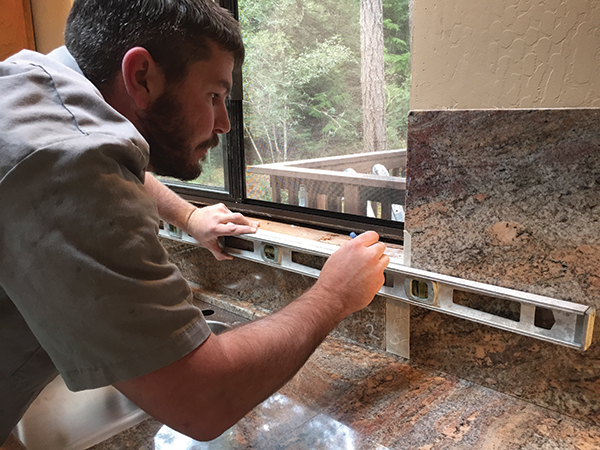A home is one of the biggest investments a person will ever make and in order to keep that home glowing and increasing in value, a well-maintained property should be the goal for years to come. Of course, a warranty will provide protection, but seasonal maintenance by the homeowner is also key to long-lasting digs. As a professional in the industry, you’ve seen first-hand what irresponsibility will do to a residence. It’s imperative to remind your buyers that even though a home may be brand spanking new, regular maintenance is absolutely necessary to ensure safety, comfort, and retain resale value.
It’s easy to preach to a homebuyer about keeping up with seasonal tasks and send them on their merry way, but why not arm them with a comprehensive list of things they should be aware of? Steer them toward RWC's "season maintenance checklist" under the Homeowner's tab. This is a great tool for homeowners to stay on top of things. Furthermore, you as the builder must have gathered hundreds of maintenance tips during your career. Offer up those tips and hints as you meet with your clients throughout the home building journey.
Just for fun, here is a home maintenance quiz that will test your know-how. While this quiz does not address every conventional home maintenance project, it does provide helpful tips that may have been overlooked.
1. How often do forced-air furnace filters need to be changed?
At least every three months during the heating season.
2. What part of the faucet usually needs to be replaced when you have a water leak?
The washer.
3. Should you run hot or cold water through your garbage disposal?
Cold water.
4. How often should the moving parts of garage doors be oiled?
Every three months.
5. What tools can you use to unclog your drains?
A plunger and a plumber’s snake.
6. What tool can be used to unclog a toilet?
Coil spring-steel auger.
7. What faucet part needs to be cleaned every three to four months?
Aerator — the screen inside the end of the faucet.
8. What can you use for traction on icy sidewalks, steps, and driveways?
Cat litter or sand — never use salt because it damages the pavement.
9. Where should the fire in your fireplace be built?
On the irons or grate, never on the fireplace floor.
10. What will prevent soot and add color to the fire in your fireplace?
Throw in a handful of salt.
11. Where should your firewood be stored?
Outside, away from your house and not directly on the ground.
12. What helps keep unpainted concrete floors easy to keep clean?
Concrete Sealer.
13. What should you use to clean unpainted concrete floors?
A solution of 4 to 6 tablespoons of washing soda in a gallon of hot water. Mix scouring powder to the solution for tough jobs.
14. Why should frozen pipes be thawed slowly?
Frozen pipes should be thawed slowly to prevent the formation of steam, which could cause the pipe to burst.
15. How often should your roof be inspected?
A qualified roofer should inspect your roof every three years.
16. What should be regularly checked on your security system?
The alarms and circuit breakers should be checked to make sure they are in working order and the sensors should be inspected one by one.
17. At what temperature should your water heater be set?
120 degrees Fahrenheit
18. How often do skylights need to be inspected?
Skylights should be inspected each time your roof is inspected so leaks don’t develop from cracks and interruptions around its seals, caulking and flashings.
19. What can you use to help a window slide easily?
Rub the channel with a piece of paraffin.
20. What should you look for when you inspect your siding yearly?
Determine if wood-sided homes need to be repainted; check to see if the caulking around the windows and doors has split and cracked, and replace the caulk; clean the mildew; trim shrubbery away so it does not touch the siding.
(Quiz provided by NAHB.org)
 You know homebuyers. They always have lots of questions. And not only just for you but they want to know about the products you used in their home. Below are many of the questions we get on a regular basis about the warranty you are providing with the homes you build. We just thought you should know in case any of these questions come up in your own conversations with your customers. If you need more information, don’t hesitate to give us a call.
You know homebuyers. They always have lots of questions. And not only just for you but they want to know about the products you used in their home. Below are many of the questions we get on a regular basis about the warranty you are providing with the homes you build. We just thought you should know in case any of these questions come up in your own conversations with your customers. If you need more information, don’t hesitate to give us a call.
What is the value of an RWC warranty to my homebuyers?
- An RWC warranty provides insured, written coverage on various items for a specific period of time.
- Third party assistance to resolve customer service issues is available under all of our programs.
- Homeowners receive a clearly written warranty document spelling out exactly what is and is not covered.
- The resale value of your buyer’s home is increased when our warranty is transferred to the next owner.
- Homeowners have assurance that assistance is available if a covered item is defective.
- Builders wishing to use RWC or an Affiliate’s warranty must demonstrate technical competence, financial stability and ethical business dealings with their customers. Knowing that your builder is a member of one of our programs is assurance that these standards have been met or exceeded.
- The average cost to repair a structural failure exceeds $30,000. Having a warranty in place means that covered structural components will be repaired without causing you or your homeowner serious financial hardship.
- There is a greater likelihood of a major structural defect developing in a home than there is a fire which causes major damage. Homeowners probably have insurance to protect against fire damage. Why not be protected from structural failures as well?
What exactly is covered under my warranty?
RWC and Affiliates have over 75 different warranty options. So the answer to this question depends on which warranty was placed on the home. Coverage varies depending on the program selected by the Builder and the state in which the home is located. Refer to the warranty book received at closing for exact coverage and warranty terms.
How does a homeowner start the claims process?
The specific procedures to address a potential defect in a home are spelled out in the warranty book. The homeowner must send written documentation either by email to RWC at warranty.resolution@rwcwarranty.com or via certified mail, return receipt requested in order to initiate this process. We do not accept telephone or fax requests at this time.
What are mediation and arbitration?
RWC knows that, in the majority of cases, the root of many disputes is the lack of communication between a builder and a homeowner. Sometimes, all it takes to get an issue resolved is someone to take on the role of mediator and assist the others in coming to a fair and reasonable agreement, based on the warranty standards provided. Prior to heading to formal arbitration or costly litigation, RWC does its best to mediate disputes between Members and Homeowners.
Arbitration is a formal process conducted by an independent, neutral arbitrator to resolve disputes between two or more parties. In the case of our warranty programs, RWC uses arbitrators experienced in arbitrating residential construction matters. Unless prohibited by law, the decision of the arbitrator under our programs is binding on all parties, including the homeowner as well as the builder.
Your buyer has questions about the paperwork received regarding their home’s enrollment (duplicate book, incorrect information on Application for Warranty, etc). How do they contact RWC?
For questions regarding the Application for Warranty Form or any other Enrollment Paperwork issue, the homeowner may contact our main office at 717-561-4480 or click here and fill out our information request form.
 The last couple decades have seen dramatic changes in the relationship between builders and their customers. A generation ago construction defect litigation rarely affected builders. In many jurisdictions, the old legal maxim caveat emptor, or “let the buyer beware”, applied to the sale of new homes. Twenty-first-century American society has turned that principle on its head. A more accurate watchword in these times is caveat builder or “let the builder beware” of litigious homeowners and plaintiffs' attorneys bent on making a lucrative monetary recovery in court for every perceived defect in every new home.
The last couple decades have seen dramatic changes in the relationship between builders and their customers. A generation ago construction defect litigation rarely affected builders. In many jurisdictions, the old legal maxim caveat emptor, or “let the buyer beware”, applied to the sale of new homes. Twenty-first-century American society has turned that principle on its head. A more accurate watchword in these times is caveat builder or “let the builder beware” of litigious homeowners and plaintiffs' attorneys bent on making a lucrative monetary recovery in court for every perceived defect in every new home.
Residential construction litigation has increased in frequency and expense dramatically in the past two decades and exponentially in the past few years. Homeowners recover hundreds of millions of dollars from builders every year, and a typical settlement of a condominium association claim is not measured in thousands of dollars, but in millions of dollars.
A recent study revealed that more than half of all homeowner claims are about actual work performed in the building of the house and not about design, materials or maintenance. These complaints can create logistical headaches for builders and can lead to litigation that is expensive and tends to distract builders from their primary focus of building and selling homes. Express home warranties reduce the work, anxiety, and expense of these kinds of claims by spelling out the rights and remedies of the parties and by providing for arbitration, a quick and relatively inexpensive method for resolving disputes.
Arbitration provisions in express warranties provide that mutually agreed upon, neutral arbitrators hear the evidence from the parties and determine, without passion or prejudice for either side, who owes what to whom. Because most arbitration services have streamlined procedures, and because there are no juries for whom the lawyers must “dramatize” the case, arbitrations often result in less expense and reduced animosity between the parties.
In today's world, there is no reason why builders or homeowners should beware of dealing with each other after the settlement on a new home. If a builder provides his customer with an express warranty administered by a neutral third party, such as a new home builder warranty by RWC, both the builder and the homeowner can enjoy peace of mind because they have a clear and written description of how the home should perform and a quick, fair, and inexpensive process for resolving any disputes that might arise. All of RWC's warranty programs include out effective warranty resolution process which includes mediation and, if needed, formal arbitration.
If you need information on the procedures and/or rates to enroll ALL your building projects (remodeling, commercial, detached garages, condominiums, townhomes, etc.) with RWC to provide yourself with the most warranty protection available, contact your Account Executive at 800-247-1812, Ext 2149.
As the saying goes, you have to spend money to make money. Of course, everyone wants the promise of a great return-on-investment (ROI) on home renovations, but not all projects will yield a lofty payout. Decisions today can make or break a sale years down the road. So how does one choose which projects to tackle? Real estate guru Homeadvisor.com states these are the top five remodeling projects that will give homeowners the best bang for their buck:
FIBERGLASS INSULATION: 107.7% ROI: New insulation isn't exactly #1 on a home owner's to-do list, but those puffy sheets of energy efficiency will warm wallets with long-lasting savings. Insulation may not be pretty to look at, but it saves money and improves comfort.
ENTRY DOOR REPLACEMENT: 90.7% ROI: Secure and attractive! A quality steel door is a great choice for a home upgrade, plus it provides extra security and prevents unwanted drafts.
MANUFACTURED STONE VENEER: 89.4% ROI: Cheaper than natural options, engineered stone siding will give a home the revival it deserves while keeping the budget in mind. And as a bonus, today's fabricated products look just like the real thing! Natural stone also tends to put stress on the frame and foundation, so it's a win-win for this lighter alternative.
GARAGE DOOR REPLACEMENT: 85% ROI: Not only an aesthetic renovation, replacing the garage door also serves other purposes such as improved security and energy efficiency. A fresh design will surely give the home's exterior a boost in curb appeal.
MINOR KITCHEN REMODEL: 80.2% ROI: Small kitchen remodels ranging from $5,000 to $25,000 boasts a favorable return. Kitchens tend to be the hub of the home, so it only makes sense to make it work in your favor. Whether simple changes or reflowing the layout -- improving the design and usability of the space will pack a punch.
 While much of the country is experiencing a healthy resurgence in home building, what is also going strong is the market for additions and renovations. For many reasons, today’s homeowners are still very likely to consider remodeling their home. For those handymen and women that are up to the challenge, tackling home improvement projects on their own can be a very rewarding experience. On the other hand, for many average Americans, DIY isn’t an acronym on their resume. Whether it’s an expanding family that needs more space or a frightfully outdated avocado green kitchen that begs for a facelift, homeowners will be scouting out professionals to get the job done.
While much of the country is experiencing a healthy resurgence in home building, what is also going strong is the market for additions and renovations. For many reasons, today’s homeowners are still very likely to consider remodeling their home. For those handymen and women that are up to the challenge, tackling home improvement projects on their own can be a very rewarding experience. On the other hand, for many average Americans, DIY isn’t an acronym on their resume. Whether it’s an expanding family that needs more space or a frightfully outdated avocado green kitchen that begs for a facelift, homeowners will be scouting out professionals to get the job done.
According to economists, the current demand for home-improvement is healthy. Per the latest Remodeling Index, remodeling activity nationwide has continued to grow and is projected to keep rising. Demographics tend to play a big role in future prosperity. As baby boomers retire, the likelihood of first floor bedrooms and bathrooms or wider doorways and hallways become a reality. On the other end of the spectrum, housing affordability may sway millennials’ decision to purchase older existing homes that will command renovations. And lest we forget Mother Nature. In the wake of the tragic flooding and hurricane-ravaged areas, countless homes have been compromised. It may be too early to tell what type of impact these storms will have on the marketplace, but rebuilding and renovating will not be a piece of cake.
How does your business fit into this niche? If you’ve been focusing solely on new home construction and haven’t given much thought to remodeling, perhaps now is the time to investigate. Could it be that you are in a position to aid in the recovery of storm-affected areas? Or simply think forward to January or February. For half of the country, the cold, winter months are right around the corner and new construction may wane. Several home improvement projects may be just the thing to fill in the gaps.
Ready to kick it up a notch? Why not check out the RWC Remodeler Warranty? Having a written warranty effectively reduces misunderstandings that can result from a verbal agreement and a handshake with clients. With RWC’s insurance backed protection, homeowners can be confident that you are a top-notch craftsman and that their remodeling project is a worthy investment.
Did you know that allergies are the sixth leading cause of chronic illness in the Uni ted States? In fact, more than 50 million Americans suffer from allergies each year; and asthma affects more than 25 million. How do you, as a builder, tackle the respiratory issue from the ground up? Clean "healthy" homes are becoming mainstream and it is where homebuyers are turning in order to combat some of these problems.
ted States? In fact, more than 50 million Americans suffer from allergies each year; and asthma affects more than 25 million. How do you, as a builder, tackle the respiratory issue from the ground up? Clean "healthy" homes are becoming mainstream and it is where homebuyers are turning in order to combat some of these problems.
The urge for wellness is compelling, however, building a healthy home can be a catch 22. While trying to prevent outdoor pollution and pollen from sneaking inside due to drafts and leaks, a home that is too airtight can actually be more tainted. Energy-efficient, well-sealed homes can trap chemicals and other irritants.
There are several factors to contemplate when trying to find that perfect balance of air quality. If healthy building standards are important to your buyers, consider these points when strategizing materials, schedules, and budgets.
• Conduct third-party certified air-quality tests to assess the particulates, then improve upon those numbers.
• Provide balanced ventilation to distribute and filter air properly. By keeping air changes to a minimum, drafty corners of homes will stay free of dust and will ensure fresh air is circulated throughout the home.
• Carbon monoxide is odorless and fatal, so it’s essential to install CO2 detectors on every floor.
• To decrease the problems from chemicals being emitted from new building materials, use as many natural products as possible. For example, select cabinets made of real wood or choose solid surface kitchen countertops such as slate, granite, or marble. This eliminates the adhesives associated with laminates.
• Taking the proper precautions to prevent mold growth is a no-brainer. Exterior insulation will warm the exterior sheathing so that the inside face of the sheathing does not become a condensing surface. Condensation in the walls means moisture which may lead to structural issues in the future. It’s also important to properly flash exterior penetrations, windows, and the roof to move water away from the home. Once water finds its way in, the home is no longer truly healthy.
• And last but not least, take pride in your work and keep a clean worksite. Clients want transparency, so by snapping a few photos of wall cavities that are free of sawdust and dirt reinforces your integrity and commitment to a healthy home.
All of RWC’s home warranty programs feature mandatory binding arbitration of Unresolved Warranty Issues.* RWC and its builder members have been very successful at persuading courts to recognize and enforce the warranty’s mandatory binding arbitration provision. Courts across the country have removed cases from the courthouse and directed them to arbitration under RWC’s Limited Warranty Program.
A good example can be found in this case study. RWC had issued a warranty on a home that was in Year 1 of home warranty coverage, and the homeowners filed a lawsuit against the builder. The builder was well-equipped to defend himself with the warranty book, the application for warranty and his own contract, which included language that made the RWC builder warranty, including the warranty’s binding arbitration language, applicable to any alleged warranty defects in the home. Even though the homeowners argued that RWC’s warranty should not be enforced in that state, the court endorsed RWC’s warranty, and the motion brought by the Builder to compel arbitration and dismiss the homeowners’ lawsuit was granted in its entirety.
Consequently, the homeowners initiated a request for home warranty performance with RWC. Prior to arbitration, the warranty provides for informal mediation. The parties agreed to use RWC’s mediation to try to settle the disputes about the alleged house warranty defects. RWC became actively involved mediating between the homeowners and the builder. Through this mediation, communication between the homeowners and the builder has improved and several items have been amicably resolved. We are encouraged that most, if not all warranty items, will soon be resolved in the same way. At the conclusion of mediation, if any items remain unresolved, the homeowners and builder will proceed to binding arbitration under the terms of the warranty.
This is a real case and a great example of how RWC’s mandatory binding arbitration provision is an effective tool in preventing litigation. It also supports the value of using RWC’s mediation process to resolve disputes about alleged warranty defects in the homes you build.
*Note that the mandatory arbitration provision is removed by the HUD addendum, and thus mandatory arbitration does not apply to home warranties placed on HUD homes.
